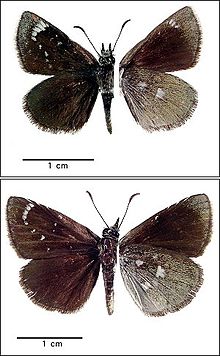
Papilio multicaudata, the two-tailed swallowtail, is a species of the family Papilionidae found in western North America from British Columbia to Central America.

Atriplex lentiformis is a species of saltbush.

Calpodes ethlius, the Brazilian skipper, larger canna leafroller or canna skipper, is a butterfly of the family Hesperiidae. It is found in the United States from southern Florida and southern Texas, south through the West Indies, Mexico, and Central America to Argentina. Strays and temporary colonies can be found north to southern Nevada, northern Texas, Illinois and Massachusetts.

Papilio indra, the Indra swallowtail, short-tailed black swallowtail, or cliff swallowtail, is a western North American butterfly in the family Papilionidae.

Polites sabuleti, the sandhill skipper or saltgrass skipper, is a butterfly in the family Hesperiidae. It is found from southern British Columbia and eastern Washington, south through California and northern Arizona to Baja California and east to south-eastern Wyoming, central Colorado, and north-eastern New Mexico. It is an introduced species in Hawaii.

Ochlodes sylvanoides, the woodland skipper, is a butterfly of the family Hesperiidae. It is found in North America from British Columbia south to southern California, east to Montana, Colorado and Arizona.

Euphilotes battoides, the square-spotted blue or buckwheat blue, is a species of butterfly of the family Lycaenidae.

Lycaena helloides, the purplish copper, is a butterfly of the family Lycaenidae. It is found in North America from the Great Lakes area to British Columbia, south to Baja California.
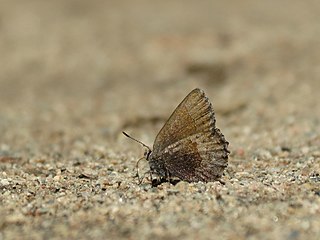
Callophrys polios, the hoary elfin, is a butterfly of the family Lycaenidae. It is listed as a species of special concern and believed extirpated in the US state of Connecticut.
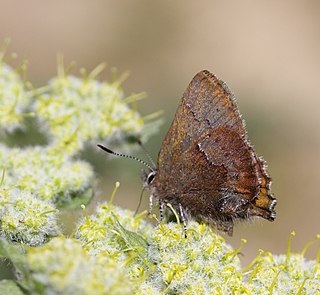
Callophrys mossii, commonly known as Moss's elfin, stonecrop elfin or Schryver's elfin, is a species of butterfly native to North America in the family Lycaenidae. It is found from British Columbia south to southern California and east to Wyoming and Colorado in isolated populations. The habitat consists of rocky outcrops, woody canyons and cliffs.

Satyrium saepium, the hedgerow hairstreak, is a butterfly of the family Lycaenidae. It is found in western North America, from British Columbia south through California into Baja California and east through northern Arizona to northern New Mexico, Colorado and Montana.

Agriades podarce, the arrowhead Arctic blue, gray blue or Sierra Nevada blue, is a butterfly in the family Lycaenidae. It is found in North America from southern Oregon to central California in the Klamath Range and the Sierra Nevada. The habitat consists of subalpine meadows.
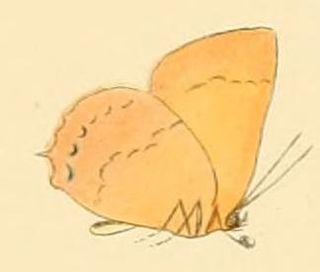
Habrodais grunus, the golden hairstreak, is a butterfly in the family Lycaenidae. It is found in North America in southern Arizona, Oregon, California and Mexico. The habitat consists of oak woodland, canyons and mountain ridges.

Anthanassa texana, the Texan crescentspot, is a species of butterfly in the family Nymphalidae. It is found from Guatemala north through Mexico to southern California, east across the southern United States to northern Florida, Georgia and South Carolina. Strays may be found up to Arkansas, Missouri, Illinois, South Dakota, and central Nevada. The habitat consists of deserts, dry gulches, open areas, streamsides, road edges, and city parks.

Lon melane, also known as the umber skipper, is a butterfly of the family Hesperiidae. It is found in California, southern Arizona, Baja California, the highlands of Mexico and Central America. The habitat consists of desert foothills, grassy areas, streamsides, roadsides, yards, parks and open oak woodland.
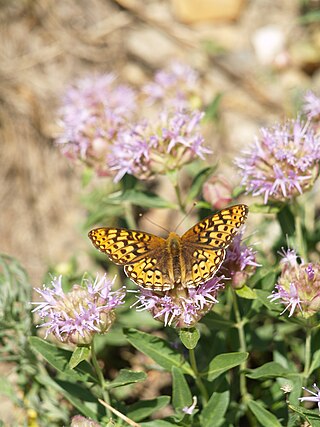
Speyeria egleis, commonly known as the Great Basin fritillary or egleis fritillary, is a butterfly of the family Nymphalidae. It is found in the United States, where it has been recorded from North Dakota southwest through Oregon to California and south to Colorado. The habitat consists of mountain meadows, forest openings and exposed rocky ridges.
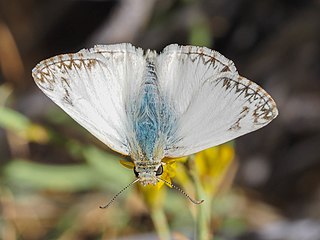
Heliopetes ericetorum, the northern white-skipper, is a butterfly of the family Hesperiidae. It is found in North America in the United States from eastern Washington south to western Colorado, southern California and Arizona, and in Baja California in north-western Mexico. The habitat consists of open woodland, chaparral, dry washes, desert mountains and arid lands.

Hesperopsis alpheus, the saltbush sootywing, is a species of spread-wing skipper in the butterfly family Hesperiidae. It is found in Central America and North America.

Hesperopsis gracielae, known generally as the Macneill's sootywing or Mcneill's saltbush sooty-wing, is a species of spread-wing skipper in the family of butterflies known as Hesperiidae. It is found in Central America and North America.
